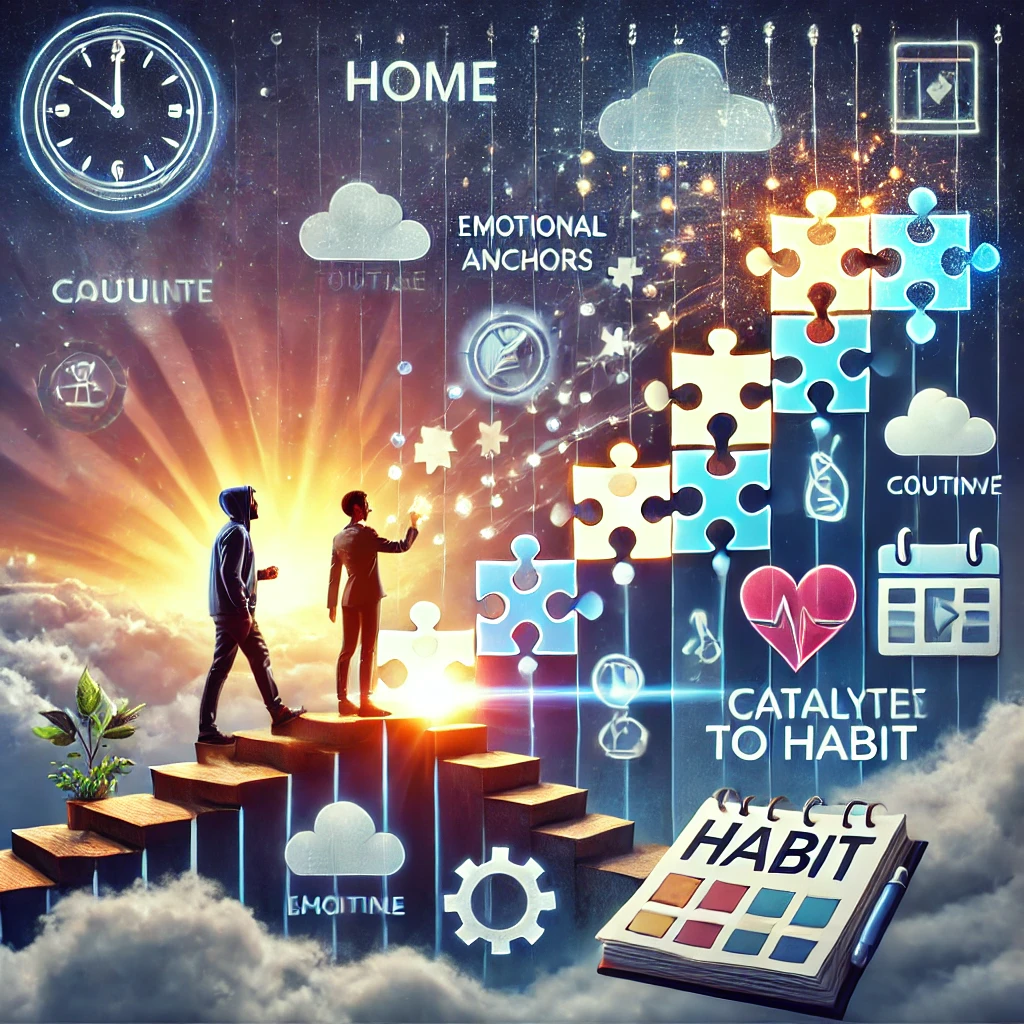The Emotional Spark of Change
You’re all in on the emotion to become a change agent. For some of us, the status quo just isn’t enough. We catch glimpses of the person we’re meant to be—more alive, more purposeful, more fulfilled. In those quiet, mundane moments of life, something stirs. That yearning is the seed of transformation. It’s not just about craving change—it’s about feeling that deeper pull to become more.
Here’s the question that separates dreamers from doers: Do we wait for life to change us? Or do we choose to be the agent of our own transformation?
The Illusion of a Fresh Start
Starting change is easy. We all know that rush—the adrenaline of a new goal, the burst of hope that comes with a clean slate. We set intentions. We map plans. We feel motivated.
But ask anyone who’s ever tried to quit drinking, lose weight, or stick to a workout routine: the excitement fades. Reality creeps in. Setbacks happen. And then? We relapse. We return to old habits. The cycle repeats.
Why? Because the beginning of change is only the surface. The hard part is what comes next—sustaining it.
Why Most Change Fails
Here’s the uncomfortable truth: many self-help books and coaching frameworks are designed to start change, not sustain it. They inspire. They motivate. They light the fuse. But when the initial spark burns out, people are left with no roadmap for what comes after.
That’s where so many fall off. The feel-good moment fades. Real life kicks in. Most people haven’t built the structure they need to keep going. What’s missing is a process for turning those new actions into lasting habits. Without that, change remains a moment, not a movement.
The Power of Emotion in Sustaining Change
Real transformation is fueled by emotion. Not fleeting inspiration, but deep personal meaning. That’s what keeps the flame alive.
Take it from someone who’s been there. For years, there was a struggle with weight loss. Everything shifted after a diagnosis of type 2 diabetes in 2000. Suddenly, it wasn’t just about shedding pounds—it was about staying alive. About being there for a wife and kids. That clarity—the emotional why—is what finally made the change stick.
When change becomes connected to what we value most—our health, our relationships, our future—it becomes non-negotiable. That’s the kind of fire that fuels discipline, even when motivation runs out.
From Catalyst to Habit
The best coaching doesn’t just help you start change—it helps you sustain it. It guides you through the messy middle and supports you as you build routines that become second nature.
To truly become a change agent, we need to create systems. We should also build structures and establish emotional anchors. These elements help turn new behaviors into habits. That’s how we move from reacting to our lives to actively shaping them.

The Change Agent – Role of Goals: Seeing Yourself as Capable
Creating systems and emotional anchors helps build new behaviors into lasting habits. But even the best structures can collapse without one critical element: the belief that you’re capable of real change. This is where goals come in—not just as targets, but as mirrors reflecting back the kind of person you’re becoming.
Setting goals is essential—but it’s only half the equation. The real magic happens when you begin to see yourself as someone who can actually achieve them, the change agent.
Too often, we set goals from a place of hope rather than belief. We want to lose the weight, write the book, and get the promotion. Yet, underneath it all, we’re unsure if we truly have what it takes. That doubt erodes our momentum before we even begin.
What creates lasting change isn’t just having a goal—it’s experiencing ourselves in action toward that goal. Every small step, every consistent choice, builds evidence. You don’t just say, “I want to be disciplined”—you live it. And as you do, your self-image begins to shift.
This is how confidence grows—not from affirmations alone, but from showing up and doing the work, even when it’s uncomfortable. As you experience more success, even in micro-wins, you start to internalize a new identity. That identity is: I am the kind of person who follows through and who is a change agent.
That shift is crucial. Because when you see yourself as capable, goals become more than distant dreams. They become expectations. And you stop negotiating with your limits.
Story: The Change Agent, The First Time You Prove It to Yourself
A woman named Tara had always dreamed of running a marathon. For years, she talked about it—bought the gear, followed running pages, even downloaded training plans. But every time she started, self-doubt crept in. “I’m not a runner,” she’d tell herself. “I’ve never been athletic.”
Then one morning, after an exhausting week at work, she laced up her shoes anyway. She ran just one mile. It wasn’t fast. It wasn’t pretty. But something shifted.
It wasn’t just that she ran—it was that she ran when she didn’t feel like it. That moment, that single mile, cracked open a new identity. She stopped seeing herself as someone trying to be a runner, and started seeing herself as someone who runs.
That’s the kind of direct experience that changes everything.
Why Experience Builds Belief: A Neuroscience and Coaching Psychology Lens
From a neuroscience standpoint, repeated experiences literally rewire the brain. This process—called neuroplasticity—affirms that every time you act in alignment with your goal, you strengthen the neural pathways. These pathways are associated with that behavior and identity. It’s not just mental—it’s physical. Your brain begins to adapt to the version of you that shows up, again and again, for what matters.
The opposite is also true: hesitation, avoidance, and procrastination can reinforce pathways of doubt and fear. That’s why the first few steps—no matter how small—are so critical. They create a new pattern, a new loop. And the more you walk that path, the more natural it becomes.
In coaching psychology, this concept is often framed as self-efficacy—a term coined by psychologist Albert Bandura. Self efficacy is your belief in your ability to execute behaviors necessary to achieve specific outcomes. It’s one of the strongest predictors of success across domains—from education to fitness to leadership.
And here’s the key: self-efficacy doesn’t grow from thinking alone. It grows from direct mastery experiences—moments where you attempt something hard and succeed. Even partial success, even struggle, counts. Because every time you face resistance and choose action, you prove to yourself: I can do this.
Effective coaches understand this deeply. They don’t just help clients set goals—they structure experiences that build self-efficacy step by step. They know that lasting change isn’t about being perfect—it’s about building belief through consistent effort and lived proof.
When you string together enough of those proof points, your identity evolves. You’re no longer pretending to be disciplined—you are disciplined. You’re not aspiring to be someone who follows through—you are that person.
And once that belief is embodied, it becomes a self-reinforcing loop. You take action because you believe you can. And because you take action, the belief grows stronger.
Visualization: Rehearsing the Goal Before It Happens

Before you take action to be a change agent, you can train your brain to experience success through visualization. It’s a technique elite athletes, traders, performers, and entrepreneurs have used for decades. Visualization activates the same neural networks as real experience—your brain doesn’t fully distinguish between imagined action and lived action.
Each morning, choose a specific goal you want to achieve for the day. Then, close your eyes and visualize it—not abstractly, but with vivid detail.
Imagine sitting in front of your screen. The markets are open. You feel calm, focused. You’re watching the charts, tracking price movements. You’re analyzing setups with clarity. Now, watch yourself take a trade—decisively, with confidence, following your process. See yourself managing risk, following your plan, and exiting with discipline.
Now, zoom out. Visualize the whole day unfolding with precision. You’re present, engaged, and deliberate. You stay composed even during volatility. You stick to your goal. You close the trading day, not with emotional exhaustion, but with quiet confidence.
This isn’t just mental theater. It’s a rehearsal that builds emotional and cognitive readiness. Frequently visualizing success with detail and emotion influences your mind and body. They start to treat that vision as reality. You begin the day not with uncertainty, but with inner alignment.
Visualization helps you embody the identity of someone who follows through. Someone who trades with discipline. Someone who achieves goals. And as that identity takes root, the outer results begin to follow.
Inspiration and Source Acknowledgment
The teachings found in The Daily Trading Coach by Dr. Brett N. Steenbarger inspire much of the insight on becoming a change agent, visualization, goal alignment, and sustainable change in this article. His work combines performance psychology with practical trading strategies. It is a foundational resource for anyone serious about personal growth and lasting transformation.

Leave a Reply